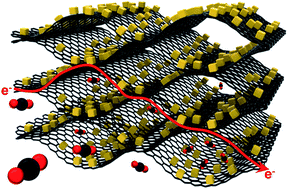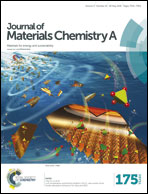Graphene/ZIF-8 composites with tunable hierarchical porosity and electrical conductivity†
Abstract
The development of hierarchical metal–organic frameworks (MOFs) incorporating interconnected micro- and mesopores has been of considerable interest in gas separation, energy storage and catalysis due to the efficient mass transfer kinetics through mesopores. Here, we report the preparation of graphene/ZIF-8 nanocomposites with tunable hierarchical porosity and surface areas, wherein the distribution of micro- and mesopores along with the particle size of ZIF-8 crystals was controlled by simply varying the annealing temperature of graphene oxide sheets. These nanocomposites showed superior CO2 uptake capacities up to 17 mmol g−1 at 303 K, 35 bar to ZIF-8 due to the synergistic effect of the graphitic surface and ZIF-8 crystals, thus offering a new direction to further improve the gas uptake capacity of MOFs, while simultaneously achieving fast mass transfer of gas molecules into the adsorbent through mesopores. Furthermore, the presence of graphitic templates (20 wt%) introduced electrical conductivity up to 64 S m−1 into an insulating MOF such as ZIF-8. Importantly, we still observed an electrical conductivity of 2 S m−1 with graphene loadings as low as 2.5 wt%. This present approach not only provides a new direction for the effective and facile synthesis of hierarchical porous materials but also paves the way for the introduction of electrical/thermal conductivity into insulating MOF structures.


 Please wait while we load your content...
Please wait while we load your content...